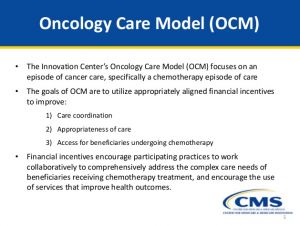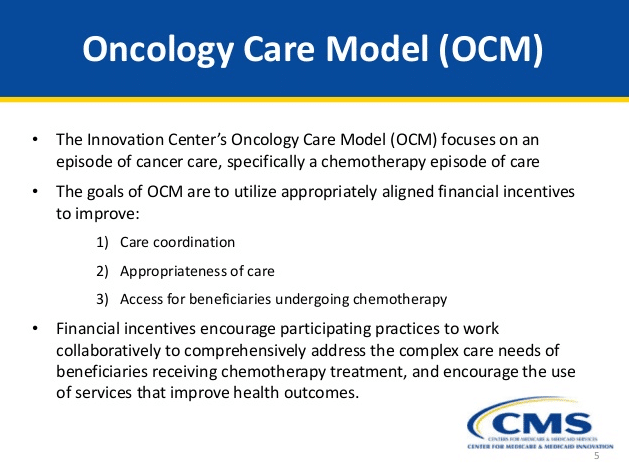We understand that some Oncology Care Model (OCM) practices are considering CMMI’s new offer to shift to upside/downside (two-sided) risk much earlier than originally planned – by January 1, 2017. As a continuing courtesy to Navigating Cancer customers who are participating in OCM, we offer some observations with regard to moving to OCM two-sided risk.
Background
 On Oct 14, 2016, CMMI announced that OCM Participants may elect two-sided risk effective Jan 1, 2017, rather than waiting until the original two-sided risk option date of July 1, 2018. According to CMMI, the OCM timeframe for electing the two-sided risk option was moved up in order to accommodate OCM Participants who wished to qualify for the Advanced APM path of the Medicare Access and CHIP Reauthorization Act of 2015 (MACRA) and thus be excused from MACRA’s Merit-Based Incentive Payment System (MIPS) path.
On Oct 14, 2016, CMMI announced that OCM Participants may elect two-sided risk effective Jan 1, 2017, rather than waiting until the original two-sided risk option date of July 1, 2018. According to CMMI, the OCM timeframe for electing the two-sided risk option was moved up in order to accommodate OCM Participants who wished to qualify for the Advanced APM path of the Medicare Access and CHIP Reauthorization Act of 2015 (MACRA) and thus be excused from MACRA’s Merit-Based Incentive Payment System (MIPS) path.
OCM Participants electing two-sided risk on January 1 are required to submit to CMMI a “Two-Sided Risk Arrangement” amendment to their OCM Participation Agreement by December 5, 2016 (less than a month from now!) and submit a follow-up “Risk Arrangement” change request by December 28, 2016.
Under the two-sided risk option, an OCM Participant’s OCM Discount would be reduced from 4% to 2.75%, effectively increasing the OCM Participant’s Target Prices and thus its chances to earn Performance-Based Payment (PBP) accordingly. However, under the two-sided risk model, an OCM Participant is “at risk” of having to pay Medicare the difference in the event that actual expenditures exceed its associated Target Amount. Where expenditures exceed the Target Amount could easily add up to hundreds of thousands of dollars owed Medicare by the OCM practice.
Gauging Your Risk
In order to make an informed and prudent decision with regard to electing two-sided risk, an OCM Participant must clearly understand the relationships of its historical baseline Medicare expenditures and Target Prices derived from applying the OCM Prediction Model / risk adjustment methodologies to its historical baseline figures. As CMMI has commented, there is no way of knowing what the Target Prices will actually be until the time of PBP Reconciliations, the first of which will begin to take place around February 2018 (initial Reconciliation of the First Performance Period).
The analysis of OCM historical claims files of a representative sample of eleven OCM Participants conducted by a Boston-based health data analytics firm found a consistent pattern of historical expenditures in excess of predicted Target Prices for a number of cancer types in the sample. This could, of course, result in negative PBP for those particular cancers for those practices. This pattern of expenditures exceeding Target Prices was particularly predominant with prostate and bladder cancers. The conclusion was that the OCM risk adjustment/pricing methodologies had an inherent “statistical bias” that would skew Target Price calculations one way or the other. In addition, an analysis of the historical expenditures of seven practices conducted by another OCM-support firm had similar findings: that there are “issues with the OCM Risk Algorithms.” CMMI has since been informed of these findings and has acknowledged that the findings are accurate.
Given the uncertainties with risk adjustment aberrations in the OCM pricing methodologies, it is difficult to envision any OCM practice assuming downside risk until there is clarity and a deeper understanding of the elements in the OCM pricing model.
For further information with regard to OCM two-sided risk or to request a demo of Navigating Cancer’s OCM solution that can enable your success with the Oncology Care Model, contact the Customer Care team today.
